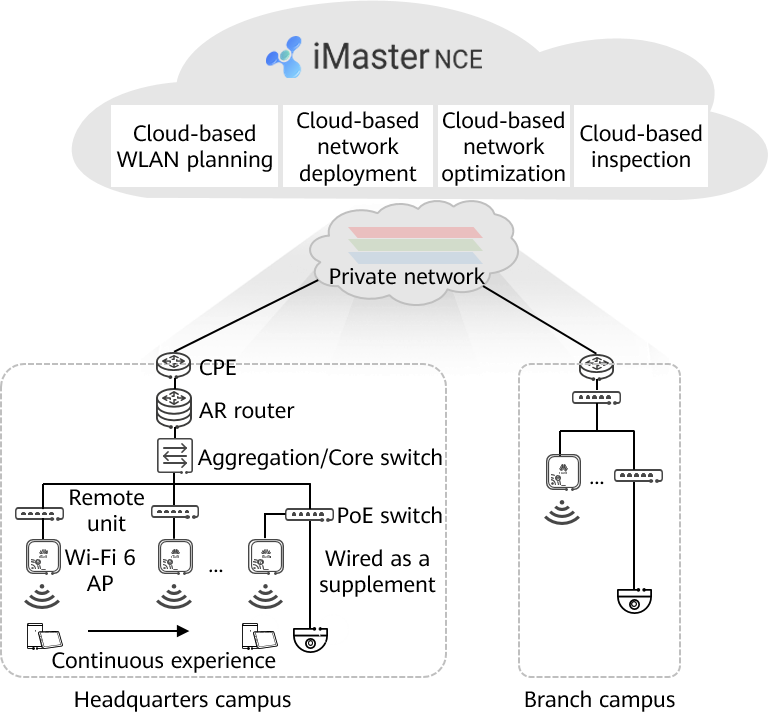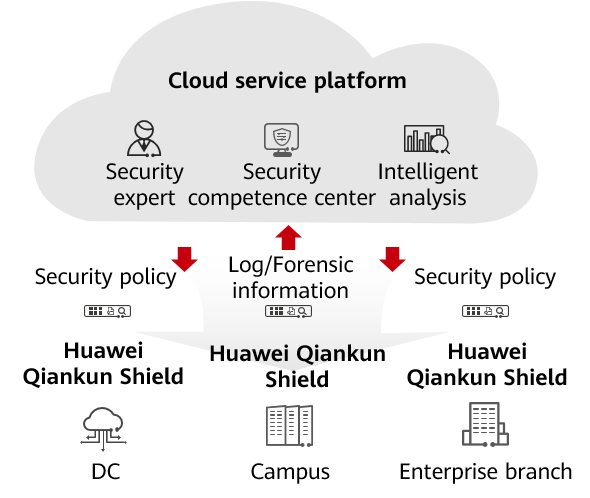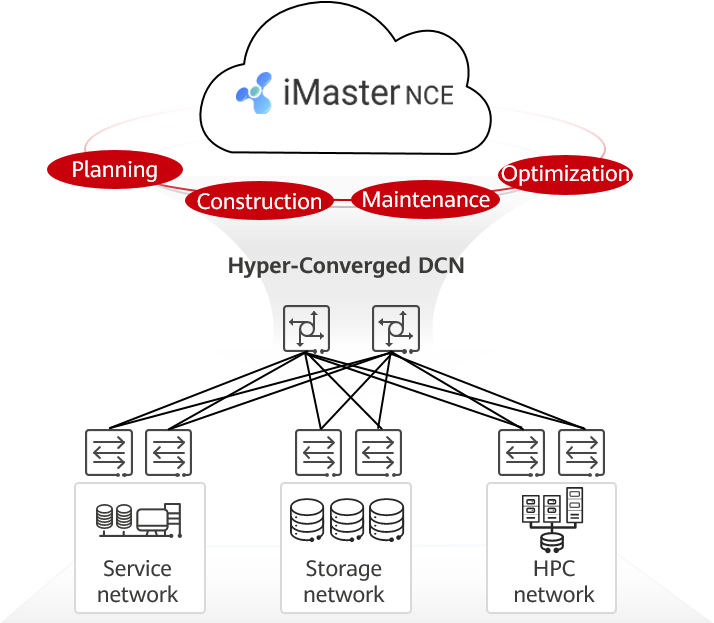What Is Private Line + Managed Services?
Digital economy is boosting and digital transformation is gathering pace across industries. To keep up, Huawei launches the private line + managed services solution. This future-oriented solution packages IP private line services with digital managed network services, such as managed LAN, WAN, security, and DCN services. The resulting benefits include upgraded quality and automation capabilities of network infrastructure and differentiated bearer of private line services.
Overall Architecture of Private Line + Managed Services
In essence, the private line + managed services solution provides enterprises with a set of one-stop ICT convergence services (private lines + networking + applications) by leveraging carriers' resource advantages. To be specific, with this feature-rich solution, carriers can fully leverage their platform advantages to package IP private line services with digital managed network services (such as managed LAN, WAN, security, and DCN services) in a unified and efficient manner. This can reduce enterprises' total cost of operation (TCO), enhance the quality and automation capabilities of network infrastructure, and enable differentiated bearer of cloud private lines. To put it simply, private line + managed services can be expressed as follows:
Private line + managed services = IP private line + digital managed network services (managed LAN, WAN, security, or DCN services)

Overall architecture of private line + managed services
Why Do We Need Private Line + Managed Services?
Looking to the whole world, top 50 countries or regions have released their digital policies. Digital transformation is also gaining momentum across industries, promoting the migration of office and production services to clouds and IT facility reconstruction of enterprise campuses. Currently, more than 90% of enterprises plan to migrate their IT systems to multiple clouds. In addition, the digital economy is developing rapidly. All of this incubates a giant market space of digital managed enterprise network services. To keep up, carriers need to provide not only private line services but also diversified network services.
When trying to meet the digital transformation requirements of small and midsize enterprises, carriers face the following challenges:
- Enterprise connection: As connections of the office networks, Internet of Things (IoT), and production networks explode, network operations and maintenance (O&M) capabilities of enterprises gradually become insufficient, and the O&M costs become record high. All of this makes service hosting a must.
- High-quality cloudification: As the e-Government cloud, healthcare cloud, financial cloud, and education cloud become increasingly mature, industry applications are going to clouds at a higher speed. However, no mechanism is available for guaranteeing the reliability and scenario-specific service level agreements (SLAs) of enterprise service cloudification.
- Security protection: The conventional boundaries of enterprise campus networks are blurred. As a result, the number of exposed surfaces keeps increasing, bringing severe security challenges. This makes enterprise security hardening urgent.
This is where the private line + managed services solution comes in. This solution provides digital managed network services and abundant product portfolios, helping carriers to transform from Internet service providers (ISPs) to managed service providers (MSPs). To better seize the opportunities of industry digitalization, carriers package private line services and various types of managed network services by leveraging the unique advantages of private lines so as to build service-oriented and converged offerings, implementing ICT service upgrades. This can significantly improve enterprise customer experience and reduce service costs.
Scenarios of Private Line + Managed Services
Private Line + Managed WAN
- Background
Enterprises are experiencing accelerated digital transformation and cloudification as well as migrating more and more applications to the cloud. However, on a conventional campus, branches have to access the cloud through the headquarters, resulting in a large latency. For this reason, introducing local breakout for quick Internet access has become essential. Beyond that, a growing number of enterprises are transitioning from traditional private lines to hybrid private lines.
Conventional WANs are facing great challenges:
- Closed WAN architecture: It is difficult to implement multi-cloud and multi-network interconnection of enterprise WANs.
- Difficult application experience assurance: Numerous applications contend for the limited bandwidth, causing service conflicts and poor user experience.
- Difficult network O&M: Manual configuration for various types of devices is inefficient and error-prone, and service traffic is invisible.
The experience-centric private line + managed WAN solution can easily cope with these challenges. It stands out with one-network connectivity for always-on multi-cloud services, intelligent traffic steering, simplified deployment, and intelligent O&M, and is ideal for building a future-proof WAN for this new era.
- Solution overview
Enterprise networks are facing issues such as closed WAN architecture, difficult service experience assurance, slow service deployment, and difficult O&M. To address these issues, the private line + managed WAN solution implements all-scenario and on-demand interconnection between enterprise branches, between enterprise branches and data centers (DCs), and between enterprise branches and clouds. With software-defined wide area network (SD-WAN) technology, the solution implements hybrid networking of MPLS private lines and other private line technologies, and provides differentiated access experience in various scenarios such as rapid enterprise cloudification, 5G fixed-mobile convergence (FMC), and flexible traffic steering by service. The resulting benefits include enhanced network service reliability and balanced service needs and IT costs, thereby redefining the full-process service experience of enterprise WAN interconnection.
The overall architecture of the private line + managed WAN solution consists of the network layer, control layer, and management layer.
- Network layer: Cost-effective NetEngine ARs are deployed to connect branches, headquarters, and public/private clouds. The overlay technology is used to build fully-meshed connections based on any links such as the Internet and conventional private lines.
- Control layer: The route reflector (RR) works with iMaster NCE to implement automatic deployment and configuration of regional networks, automatic policy provisioning, route advertisement between sites in a region, and network connectivity between regions.
- Management layer: iMaster NCE manages the entire process of enterprise interconnection services. It uses NETCONF or YANG in the southbound direction to centrally manage devices such as RRs and CPEs, orchestrates mappings between CPEs and RRs, configures and orchestrates different VPN network topologies, and manages and provisions network service policies. In addition, it provides standard northbound RESTful interfaces to interconnect with third-party applications and cloud platforms.
Architecture of the private line + managed WAN solution - Solution advantages
- Fast deployment: simplified deployment via Zero Touch Provisioning (ZTP), rolling out services in minutes without site visits
- Broader management: rights- and domain-based management of multiple tenants, meeting diversified management requirements of enterprises; one-network unified management, reducing the TCO by 30%
- Ultimate experience: 5G FMC and backup, eliminating service interruptions; innovative adaptive-FEC (A-FEC), ensuring lossless audio and video services even at a packet loss rate of 20%
Private Line + Managed LAN
- Background
The majority of enterprises' digital services still run on conventional network architectures. This cannot guarantee the experience of enterprises' digital services and hinders the digitalization pace of enterprises. Conventional networks are facing the following challenges:
- Wireless network connections are preferred by enterprises, and therefore their quality is one of the key factors that affect the office efficiency of employees. The conventional wireless network is prone to coverage holes, has many network breakpoints, and does not support roaming. Generally, high-concurrent download of masses of files needs to contend for the network bandwidth for audio and video services, leading to frame freezing of these services.
- As IoT and inter-generational Wi-Fi upgrade gather pace, the network scale and power consumption keep increasing. In addition, the production OT, production IT, and office IT networks are separate from each other in the conventional architecture, seriously affecting the production efficiency.
- In this era where people, things, and applications keep changing, network faults frequently occur and are hard to locate. Even though network O&M teams have been working day and night, they still cannot handle all the network issues.
- Conventional networks cannot meet enterprises' digital transformation requirements.
The private line + managed LAN solution can easily cope with all of these challenges. It stands out with simplified network management and O&M, rapid service rollout, and guaranteed service experience, and is ideal for building a future-oriented campus network that can better embrace this new era.
- Solution overview
The private line + managed LAN solution adopts a host of cutting-edge technologies such as IoT, Wi-Fi 6/Wi-Fi 7, SDN, SD-WAN, cloud management, and AI, helping enterprises to build a campus network that features simplified O&M, a simplified network architecture, simplified branches, and ultimate user experience. With this solution, enterprises benefit from ultrafast wireless, seamless communication and collaboration anytime, anywhere, agile provisioning of cloud applications, and guaranteed reliable application experience. In this way, organizations across sectors including government, education, healthcare, manufacturing, finance, energy, retail, and transportation can quickly seize new opportunities for digital transformation in the cloud era.
Based on the cloud-managed LAN or WLAN, the solution allows carriers to extend private lines to campus networks and provide cloud-managed network services that integrate LANs, WLANs, and IoT. These services include plug-and-play fast delivery and intelligent O&M-enabled fault diagnosis in minutes, reducing onsite services by more than 80% and shortening the return on investment (ROI) cycle by 20%. The solution stands out with the following highlights:
- Cloud-based WLAN planning: With WLAN Planner, WLAN planning can be completed in five simple steps. This shortens the network construction period by more than 30%, multiplies simulation efficiency, and improves the drawing efficiency by three times.
- Cloud-based network deployment: The solution implements offline service configuration on clouds and automatic configuration delivery to devices, enabling device plug-and-play.
- Cloud-based network optimization: Based on the network topology, the solution can proactively notify administrators of network faults, locate root causes with just one click, and analyze the fault impact on services.
- Cloud-based inspection: The solution supports AI-powered user graph setup and global dynamic adjustment of radio resources, maximizing the network performance.
Architecture of the private line + managed LAN solution - Solution advantages
- Fast delivery: Online network planning, device plug-and-play via barcode scanning, and simplified network architecture, reducing the TCO
- Ultimate experience: High-quality signal coverage with no blind spots, interruption-free roaming, and optimal application experience without rate reduction, improving user satisfaction
- Simplified O&M: Intelligent O&M, proactive fault prediction, automatic network optimization, and end-to-end (E2E) visualization and management of applications, reducing user complaints
Private Line + Managed Security
- Background
In this new era with all things connected and moved to clouds, people's working mode is shifting from local office to remote collaborative office. This blurs the access boundaries. The network access mode is changing from the conventional access of PCs in wired mode to diversified access of various terminals (such as cameras, printers, and air conditioners anywhere) via Wi-Fi or 5G technologies. This blurs the IoT boundaries. In addition, conventional DCs are transforming towards cloud DCs. This blurs service boundaries. All of this is blurring the network security boundaries, bringing new security challenges. To overcome these challenges, many countries or regions have issued a list of laws and regulations. For example, China has issued the Cybersecurity Law of the People's Republic of China and Regulations on Critical Information Infrastructure (CII) Security Protection. This poses higher requirements on network security. Network and security are the key foundations for enterprises' digital transformation. The private line + managed security solution supports service subscription via software as a service (SaaS), real-time online upgrade, and 24/7 dynamic defense, safeguarding enterprise network security.
- Solution overview
The private line + managed security solution adopts an innovative cloud-edge integration architecture, and is ideal for building one-stop security cloud services. To begin with, "cloud" in the architecture refers to the cloud service platform. The security competence center on the platform offers border protection and response capabilities, implementing a host of functions such as application identification and control, faulty host monitoring on the intranet, and security event analysis. Leveraging AI technology, the solution intelligently correlates and analyzes security logs and forensic files to handle attacks rapidly and accurately. The solution also provides the cloud expert service — WeiRan Lab security experts experienced in attack-defense confrontation provide 24/7 online services. "Edge" refers to Huawei Qiankun Shield devices. These devices collect and send security logs to Huawei Qiankun cloud platform through encrypted channels to provide data for AI analysts. They also perform in-depth security detection on network traffic to discover and block attack traffic and malicious files. Moreover, they can receive blacklist information delivered by the cloud and block unauthorized IP addresses.
To sum up, the private line + managed security solution packages firewall capabilities (such as intrusion prevention and antivirus) and cloud-based service capabilities, helping carriers provide affordable security service packages for small and midsize enterprises. In this manner, enterprises can subscribe to security services such as border protection and response, terminal detection and response, and ransomware protection online to handle security threats in seconds and enjoy 24/7 remote expert services. This can reduce enterprise investment and security maintenance labors.
Architecture of the private line + managed security solution - Solution advantages
- Fast provisioning: cloud-based SaaS services, online subscription to multiple security services, and ZTP for the local Qiankun Shield devices
- Fast upgrade: real-time upgrade of cloud-edge defense capabilities, and global sharing of any detected threat, implementing immunity in minutes
- Fast handling: cloud-edge integration, real-time awareness, automatic security policy delivery, and threat handling within seconds
Private Line + Managed DCN
- Background
As next-generation information technologies such as cloud computing, big data, and AI gather pace, digital technologies have penetrated into every aspect of our daily life and changed all industries. As an important part of computing power infrastructure and information infrastructure, DCs carry a multitude of application services such as AI, Internet of Things (IoT), and blockchain. However, DCs are facing many new challenges:
- Difficult multi-cloud and multi-DC management: As enterprise DCs develop towards multi-cloud and multi-heterogeneous DCs, service scenarios are growing in complexity and diversity, posing higher requirements on network openness and as-a-service offerings.
- Difficult automatic reconstruction: Network construction and change depend on manual experience. Manual sorting of service plans requires several months. Manual review is prone to errors, there is no verification for service rollout, and no automatic network reconstruction solution is available.
- Network packet loss: Ethernets are natively prone to packet loss, and cannot be used to build high-performance computing (HPC) and high-end storage networks that are sensitive to packet loss.
The private line + managed DCN solution consists of the L3.5+ autonomous driving network (ADN) solution, CloudFabric Easy lightweight SDN solution, and hyper-converged DCN solution, and is ideal for helping enterprises to gain true wisdom from transient data, accelerate digital transformation, and promote the digital economy development.
- Solution overview
The private line + managed DCN solution helps enterprises to build an intelligent, lossless, ultra-broadband, and green network. This feature-rich solution consists of two components: CloudEngine DC switch and intelligent network management and control system — iMaster NCE-Fabric. The solution stands out with the following highlights:
Centralized management and control of multi-cloud and multi-vendor heterogeneous networks in the multi-site, multi-DC architecture
The innovative network digital map technology of iMaster NCE-Fabric enables the industry's first L3.5+ DC ADN. This can enhance digital O&M of multi-cloud and multi-heterogeneous DCs and improve the service rollout efficiency on cross-cloud heterogeneous networks.
The solution includes the intelligent and simplified DCN solution — a lightweight SDN solution for small and midsize DCs, which enables factory pre-installation and automatic commissioning. The resulting benefits include 50% lower service costs, rapid service rollout (in three simple steps), and 100% configuration accuracy.
Typically, DCs contain three types of service networks: HPC, storage, and general-purpose computing. To maximize computing power and network performance, the solution enables the three networks to be built on an all-Ethernet architecture, giving rise to the lossless NoF+ storage network and lossless HPC network. This reduces the TCO by more than 30% and accelerates the cloudification pace of enterprises.
Huawei CloudFabric 3.0 hyper-converged DCN - Solution advantages
- Simplified protocol: FC, IB, and ETH protocols replaced by the IP protocol, reducing the TCO by more than 30%
- Simplified deployment: unified management of clouds and networks, shortening the time to market (TTM) from days to minutes
- Simplified maintenance: industry-leading network digital map, speeding up fault locating from hours to minutes
- Author: Yao Bohan
- Updated on: 2023-08-25
- Views: 1481
- Average rating:










